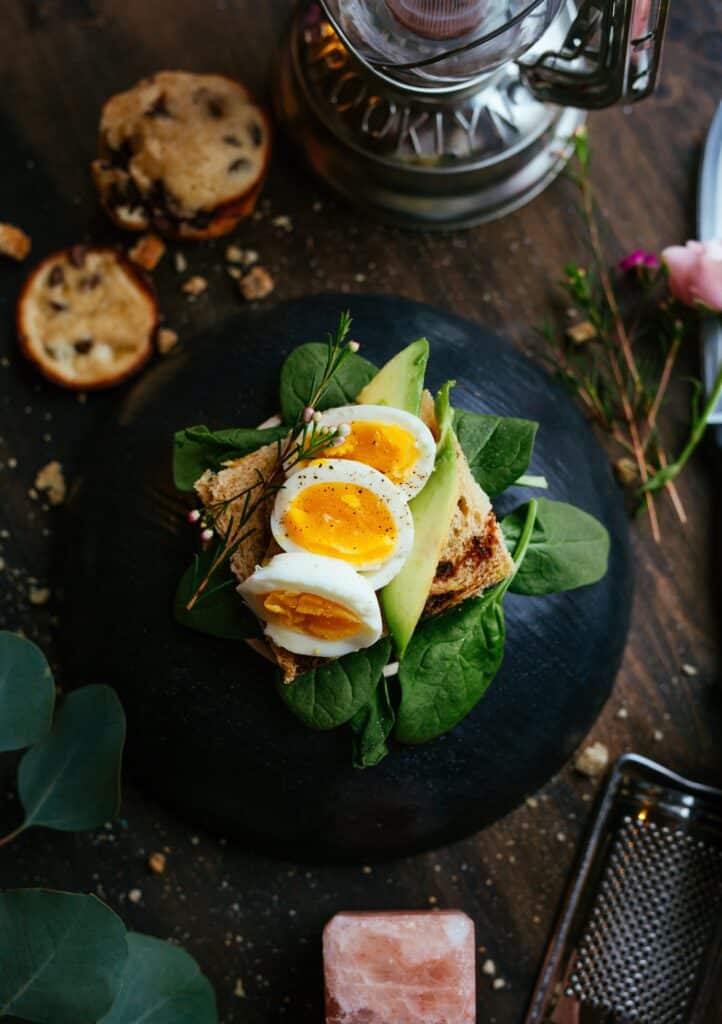20. Use layers.
Add items like napkins, cutlery, stacked plates, crumbs, and even a newspaper to add more depth and interest to your images. You can use a similar method to arrange the main dish as well. It’s easy to get carried away with adding these extra props, so make sure you don’t add items that are too busy or could distract from the main dish.
21. Portray movement in the picture.
Even though it’s a still image, we want it to look more dynamic. The goal is to make the image appear as if something is happening in it using elements like swirls or crumbs. The direction in which you choose the movement also helps guide the viewer’s eye through the elements in the image.
22. Experiment with textures.
Most of the time, the food itself will have multiple textures or layers. For example, if you cut a piece of orange, you can see the texture inside, compared to its smooth exterior, which can attract the viewer’s attention. If your food doesn’t have a lot of natural texture, add garnishes and props. Sprinkle some seeds, add a side of sauce, or dip in your image to create the impression that your food is crunchy, chewy or any other texture you’d like.
23. Create a lush effect.
When taking food photography for social media pages, it’s important to consider the staging of the food. For a lush effect, the food must look luxurious. So use as many colors, textures, shapes, and types of food as possible in the most decorative way possible for a magical effect. The food must appear fit for royalty.
24. Pay attention to color.
When it comes to food, the most important element to consider is color. Use seasonal ingredients and image retouching to bring out the colors on the screen. If you have a soft, muted background, use foods that have radiant colors that jump out of the photo. You can also use colors like red or yellow that evoke emotions. Learn the basic combinations of the color wheel and the effect certain combinations have on viewers.
25. Use different shapes.
When creating an overall scene, the shape of the food layout can guide the viewer’s eye and create a focal point. Add interest using the shape of the food or cut ingredients. For example, if you have a round plate, you can use foods of different shapes and structures to create interest and define the overall scene.
26. Create a food story.
Having a narrative will help you compose, style, and light your food subject. Create a story that evokes emotions and nostalgia in viewers. For example, imagine a photo of a steaming cup of coffee on an otherwise empty table with a dark background. Now imagine the same cup of coffee near a window, next to an open book. Although the subject is the same, the story it conveys is completely different. In food photography, you can do this by documenting the cooking process, or showing where the ingredients were sourced.
27. Don’t let the food sit.
As your dish waits to be photographed, over time it starts to look unappetizing and tired. Many dishes with lettuce leaves and herbs quickly wither as soon as they are placed on the table. Meat dishes tend to dry out as minutes pass and will need to be lightly brushed with oil in order for them to come back to life.
28. Consume beautiful images.
Looking at the work of other photographers in your field can help spark your inspiration. The simplest way is to spend a few minutes every day browsing through Instagram accounts that specialize in food photography. If you’re unsure about the account names, check out the top social media hashtags related to food photography.
29. Collaborate with other food photographers.
Start small for your first collaboration with a photographer. It takes time to understand people’s communication styles and workflows, so it’s best to start with something simple. When providing feedback, ask it like a question. This is a good way to get into the person’s thought process. Questions like… “how can we make it seem more…” or “is there a way to…” are good starting points.
30. Keep practicing.
Every food photographer has his or her own style. You can only develop a signature style by experimenting with different angles, techniques, and lighting. There are many resources that can guide and inspire you. You can find inspiration in cookbooks, culinary magazines, advertisements, and social media.
Food photography is an art that requires patience, creativity, and high skill. As a photographer, you must capture the essence of food in an attractive and appealing way. Whether you are a beginner or an experienced food photographer, having a portfolio is essential to showcase your work to potential clients. Format has plenty of templates that you can use to create your food photography portfolio.
